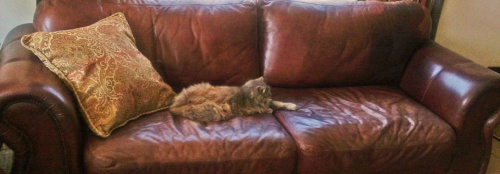Difference between revisions of "Cat fur"
| Line 9: | Line 9: | ||
| − | Cat leather and cat [[Fur - Fur skin|fur]] mainly | + | Cat leather and cat [[Fur - Fur skin|fur]] mainly come from East Asia and are used for fur collars on [[leather clothing|clothing]] or for stuffed animals. Up until the 1970s, pharmacies in Europe sold cat skins as a protection against rheumatism. |
According to estimates, two million cats and [[Dog leather|dogs]] are processed worldwide this way every year. | According to estimates, two million cats and [[Dog leather|dogs]] are processed worldwide this way every year. | ||
| − | + | The sale of cat [[Fur - Fur skin|fur]] is banned in a lot of countries. According to REGULATION (EC) No 1523/2007 and by the German Animal Products Trading Act (TierErzHaVerbG), it is generally forbidden to sell [[Cat fur|cat fur]] and dog fur, as well as products containing such fur, in the EU or from the EU to other destinations. But, transporting these across borders for non-business reasons is permitted. | |
| − | However, these regulations relate only to the [[Fur - Fur skin|fur]] of cats and [[Dog leather|dogs]]. There are no restrictions on sales of [[Smooth leather|hairless leather]] | + | However, these regulations relate only to the [[Fur - Fur skin|fur]] of cats and [[Dog leather|dogs]]. There are no restrictions on sales of [[Smooth leather|hairless leather]] from dogs and cats or animal hair without skin. Teeth, claws or bones are also not subject to any restrictions. There is no explanation for this. |
The consumption of cat or dog meat is regulated in Germany. This is prohibited in Germany according to § 22 of the Food Hygiene Ordinance. | The consumption of cat or dog meat is regulated in Germany. This is prohibited in Germany according to § 22 of the Food Hygiene Ordinance. | ||
| Line 34: | Line 34: | ||
<br> | <br> | ||
<p align=center> | <p align=center> | ||
| − | <flashow> | + | <flashow>//www.youtube.com/v/JjPr6dqvKDc&fs=1&color1=0x660000&color2=0x550000&border=1|width=500|height=281,25</flashow> |
</p> | </p> | ||
<p align=center> | <p align=center> | ||
Revision as of 15:04, 23 March 2017
Cat leather and cat fur mainly come from East Asia and are used for fur collars on clothing or for stuffed animals. Up until the 1970s, pharmacies in Europe sold cat skins as a protection against rheumatism.
According to estimates, two million cats and dogs are processed worldwide this way every year.
The sale of cat fur is banned in a lot of countries. According to REGULATION (EC) No 1523/2007 and by the German Animal Products Trading Act (TierErzHaVerbG), it is generally forbidden to sell cat fur and dog fur, as well as products containing such fur, in the EU or from the EU to other destinations. But, transporting these across borders for non-business reasons is permitted.
However, these regulations relate only to the fur of cats and dogs. There are no restrictions on sales of hairless leather from dogs and cats or animal hair without skin. Teeth, claws or bones are also not subject to any restrictions. There is no explanation for this.
The consumption of cat or dog meat is regulated in Germany. This is prohibited in Germany according to § 22 of the Food Hygiene Ordinance.
In order to avoid the word "cat", which sounds unpleasant to the western customer, traders often use names such as "Lipi", "Genotte", "mountain cat", "wild cat" or just "orthopaedic leather". End consumers never know that usually all these items are made using domestic cats.
Even for professionals, it is difficult to recognize which animal a fur is from. Therefore, it cannot be excluded that such furs or leather are processed in Asia and imported into Europe.
Additional information
Video about leather of different animal species
Leather of different animal species - Exotic leather
Other exotic leather
- Alligator leather
- Alpaca fur
- Antelope leather
- Armadillo leather
- Bird leather
- Bull testicles
- Caiman leather
- Camel leather
- Carpincho leather
- Chicken leather
- Crocodile leather
- Dog leather
- Donkey leather
- Elephant leather
- Fish leather: Eel, shark, salmon, moray eel, stingray and many others
- Frog leather - Toad leather
- Giraffe leather
- Hippo Leather
- Horsehide - Horse leather
- Kangaroo leather
- Llama Fur
- Lizard leather
- Ostrich leather
- Pangolin leather
- Peccary leather
- Rumen leather
- Sealskin leather
- Snakeskin
- Turtle skin
- Walrus leather
- Yak leather
- Zebra hide









 a kotori web solution
a kotori web solution